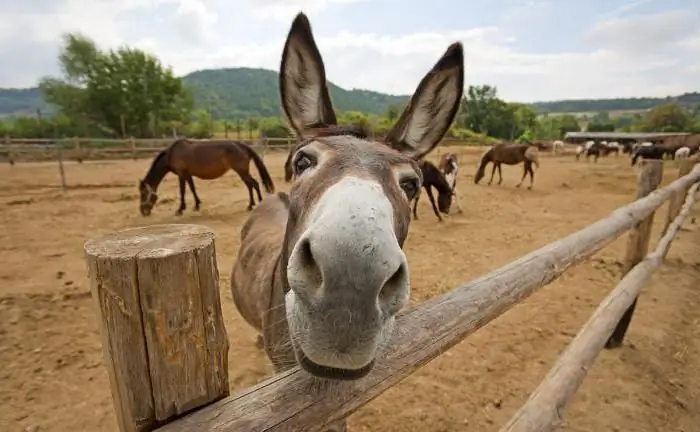- Author Henry Conors [email protected].
- Public 2024-02-12 02:41.
- Last modified 2025-01-23 09:07.
In the Caucasus, among the majestic beautiful rocky mountains, many fast rivers flow. One of them will be discussed in more detail in this article.
General information
Psou is a river separating the territory of Abkhazia and Russia. It flows along the entire border line between states. Translated from the Abkhaz language, its name means "long river", although in reality this is not entirely true. Its total length is only 53 kilometers.
The banks of this fast mountain river are covered with amazingly beautiful green forests and diverse vegetation.

The river belongs to the territory of the Western Caucasus. Psou, as noted above, has a special and important task - it forms a water border between the two states, namely, between the Russian Krasnodar Territory and the Gagra region of Abkhazia.
Its source is high in the mountains (Adepsta slope), and the mouth of the Psou River is near the Black Sea. The total area of the basin is approximately 421 square kilometers. The river flows along the eastern outskirts of the resort city of Sochi(Adler district).
A brief history of the border along the Psou River
Psou is a river that until 1920 did not yet serve as a border river. Until the middle of the 19th century (until 1864), it flowed through the central part of the land of the Sadz (one of the Western Abkhaz ethnic groups). Its upper reaches were located on the territory of another free Abkhazian settlement - Aibga.
Immediately after the end of the war, the western Abkhazians were evicted to Turkey, and the Black Sea District was formed on the liberated lands in 1866, the borders of which ran from the city of Tuapse to Bzybi.
This district in 1896 was transformed into the Black Sea province, which subsequently existed until the October Revolution of 1917. All this time, the Psou River was an inland water flow and, again, did not perform any border functions.
The troops of the Georgian Democratic Republic occupied the territory of Abkhazia in 1918. Due to the fighting between Denikin's volunteer army and Georgian troops in the Sochi-Gagra region, the border of Abkhazia on the western side could not be determined for a long period of time. It was only after Russia's short-term recognition of Georgia's independence in 1920 that an agreement was signed marking the border along the Psou River.

Psou River: photo, description of the area
Despite its relatively short length, the river is full of water and quite stormy. Like many other mountain rivers, it has a very fast current, forming numerouswhirlpools. The high level of precipitation in the western part of the Greater Caucasus ensures the full flow of the flow.
The Psou River (Abkhazia) begins not from the Main Range, but from its nearby spurs. These are the Atezhert and Ayumga ranges. The upper reaches of the river are surrounded by the Tury mountains. This is a rather harsh area with mountains formed by volcanic rocks. The upper slopes are densely overgrown with fir trees, and a little lower, beech species appear, and then (even lower, in the valley) - mixed forests with oaks and maples. Sometimes there are also fruit trees entwined with different types of vines (clematis, wild grapes, periploca, sarsaparilla, etc.).

Food and tributaries
Psou is a river that feeds at first (at the very source) with groundwater on the tops of the mountains. As the current flows, various tributaries join the Psou, which also (like precipitation) contributes to its full flow. The river, thanks to all of the above factors, becomes strong and powerful. It keeps the water level even in the hottest and hottest periods of the year.
In winter, the river does not freeze completely - only in places and only during the coldest days.
Due to the unique terrain, the right tributaries flowing into the Psou from the Russian territory are richer and longer than the left ones. Particularly distinguished from them are such rivers as Bezymyanka, Glubokaya, Arkva and Mendelikh. From the side of Abkhazia, the Pkhista River can be distinguished from the left tributaries.

Geography
The Psou bed runs almost parallel to the Mzymta River. However, unlike the second, Psou is a river flowing, as noted above, from the spurs of the Main Caucasian Range. First it flows to the west, then to the northwest, and then, gradually turning to the left, forms a slightly gentle arc and heads south. It flows into the Black Sea near Adler. This is about eight kilometers from the mouth of the very Mzymta River.
The upper reaches of the Psou River are surrounded by the Turii Mountains, formed by granite, limestone and volcanic rocks. These are very high mountains (Ajituko peak reaches a height of 3,230 meters).

Microdistrict Vesele-Psou
This original name belongs to one of the microdistricts located in the Adler district of Sochi. The village is a cozy resort town, where thousands of tourists come every year. It was named so not by chance, because the eastern border of the district runs along the river of the same name.
The village mainly consists of private buildings. There are, of course, a small number of multi-storey modern buildings. The infrastructure of the microdistrict is quite developed - there are shops, a school, a kindergarten and a clinic.
In conclusion: briefly about the population of the area
Until the middle of the 19th century, the main part of the population of the Psou valley were ethnic Abkhazians. However, after the expulsion of Muslims to Turkey, this valley practically lost its inhabitants. Only in the last decades of the same century, the territories were inhabited by Armenians, Russians, Greeks, Estonians and other peoples. By the way, they still live in these wonderful paradise places.






